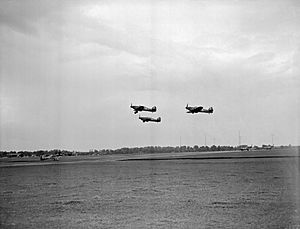Battle of Barking Creek facts for kids
Quick facts for kids Battle of Barking Creek |
|||||||
|---|---|---|---|---|---|---|---|
| Part of the Western Front of World War II | |||||||
 A flight of No. 151 Squadron Hurricanes, a squadron involved in the incident, taking off from North Weald |
|||||||
|
|||||||
The Battle of Barking Creek was a sad event that happened over England on 6 September 1939. It was a "friendly fire" incident, meaning British planes accidentally attacked other British planes. This accident caused the first death of a British fighter pilot in World War II.
What Happened?
Early on September 6, 1939, a radar problem caused a false alarm. It seemed that unknown aircraft were flying towards the Essex coast. No. 11 Group RAF ordered six Hawker Hurricane planes to take off quickly. These planes were from 56 Squadron at North Weald Airfield. The leader, Group Captain David Frederick Lucking, sent up all 14 planes from the unit. Two other pilots secretly followed in reserve planes.
More planes were sent up from other squadrons. These included Hurricanes from 151 Squadron and Supermarine Spitfires from 54, 65, and 74 Squadrons. None of the Royal Air Force pilots had fought in a battle before. Few had even seen a German plane.
Communication between the pilots and ground control was not good. There was no clear way for pilots to tell if a plane was British or German. Special "Identification Friend or Foe" (IFF) systems were still being developed. Many RAF planes did not have them yet.
Everyone in the sky expected to see enemy planes. 'A' Flight of 74 Squadron saw what they thought were German aircraft. Their commander, Adolph "Sailor" Malan, reportedly told them to attack. Two pilots, Flying Officer Vincent 'Paddy' Byrne and Pilot Officer John Freeborn, opened fire. Malan later said he shouted "friendly aircraft – break away!" But Byrne and Freeborn did not hear him.
Squadron Leader Edward Donaldson from 151 Squadron helped prevent more losses. He told his pilots that the attacking planes were British. He ordered them not to shoot back.
Sadly, Frank Rose and Pilot Officer Montague Hulton-Harrop were shot down. Hulton-Harrop was killed. He was hit in the head by fire from John Freeborn. His Hurricane plane crashed at Manor Farm in Hintlesham, Suffolk. Montague Hulton-Harrop was the first British pilot to die in the war. His Hurricane was the first plane shot down by a Spitfire. Another Spitfire was also shot down by British anti-aircraft fire.
What Happened Next?
The Court Case
John Freeborn and Paddy Byrne faced a court martial. This is a military trial. It was held at Bentley Priory, the main base for Fighter Command. The trial was kept private. Some records were released in 2019, but the full trial details are still secret.
Some reports say that Freeborn felt his commander, "Sailor" Malan, tried to avoid taking responsibility. Malan spoke against his own pilots in court. He said Freeborn was careless and didn't listen to important messages.
The court decided that both pilots were not guilty. They ruled that the incident was an "unfortunate accident." This tragic event was later called 'the Battle of Barking Creek' by people in the RAF.
This incident showed that the RAF's radar and identification systems needed to be better. These systems were greatly improved before the Battle of Britain.
The Pilots' Lives
Montague Hulton-Harrop is buried at St Andrew's Church in North Weald. His grave is a war grave.
Group Captain David Frederick Lucking, who was in charge, was moved to other duties. He later became an air commodore. He died in 1970.
Frank Rose was killed in action over France on May 18, 1940.
"Sailor" Malan became one of the most successful Allied fighter pilots. He shot down 27 German planes. He received many awards, including the Distinguished Service Order and the Distinguished Flying Cross.
Paddy Byrne was shot down and captured over France in 1940. He was held as a prisoner of war. He later returned to England. He could not fly in combat again due to his health.
John Freeborn flew more hours in the Battle of Britain than any other pilot. He continued flying missions for the rest of the war. He was an amazing airman. He received the Distinguished Flying Cross and rose to wing commander. Freeborn later shared his story in books. In 2009, he said he thought about Hulton-Harrop's death almost every day. Freeborn died on August 28, 2010.
See also
- Air attack on the fortress of Koepenick
- Friendly fire incidents of World War II


